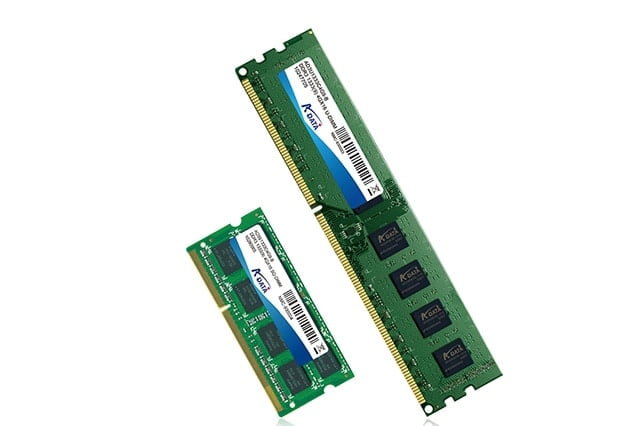Table of Contents
Understanding RAM (Random Access Memory)
RAM (random access memory) is one of the essential components of any computer system. The RAM system allows the system to access random read-write anywhere in memory based on the memory address, so the data stored in the RAM is only temporary when power is turned off. Power supply. Moreover, the large amount of RAM memory means that it can keep data of as many programs running parallel to the system at the same time, so the device’s multitasking capability will be easier.

However, there are many types of RAM which are suitable for many purposes and of course, the price segment is different.
In this article, we will briefly learn about the differences between some of the most commonly used SDRM types like DDR1, DDR2, DDR3, DDR4, DDR5 and SDRM.
Available RAM types
· SDRAM (Synchronization Dynamic Random Access Memory – Synchronous Dynamic Random Access Memory)
– DDR SDRM (Double Data Rate SDRM – Dual Data Rate SDRM)
– DDR2 SDRM (Double Data Rate to SDM – Dual Data Rate SDRM 2)
– DDR3 SDRM (Double Data Rate 3 SDM – Dual Data Rate SDM 3)
– DDR4 SDRM (Double Data Rate Fourth SDM – Dual Data Rate SDM 4)
DDR5 – The Monster of the Future!
SDRAM Dynamic Synchronous RAM
It can be seen that the term “synchronous” also partially indicates the behaviour of this type of DRM. In late 1996, SDRM (Synchronous Dynamic Random Access Memory) began to appear in computer systems around the world. Unlike previous RM technology,

SDRAM is ready to automatically coordinate with CPU time. This allows the memory controller to capture the clock cycle precisely while the requested data is ready for use, so the CPU no longer needs to wait between cycles. Memory access, thus significantly improving the overall speed of the system. Example: PC66 SDRAM runs on 66MT / s, PC100 SDRAM 100MT /s, PC133 SDRAM runs on 133 MT / s, …
SDR can be used to summarize the SDR (single data rate SDR), where, I/O, the internal clock and the bus clock are the same. For example, the I/ O of pc133, the internal clock and the bus clock are all 133Mhz. Single data rate means that SDRM can read/write only once in the clock cycle. In short, SDRAM can run at a clock much higher than regular memory.
DDR SDRM (Dual Data Rate Synchronous Dynamic RAM)

DDR SDRM (Dual Data Rate Synchronous Dynamic RAM)
The next generation of SDRAM is DDR (double data rate). As the name suggests, The DDR SDR is an improvement on SDR memory with double the transfer rate of The SDR by transferring 2 times per memory cycle, which doubles the transfer rate. Data without increasing the frequency of the clock. Thus, the boundary rate of DDR SDRM is twice as much as the SDR SDM without changing the internal clock. DDR SDRM is by default the first generation of DDR memory, with a 2-bit preface buffer, double the SDR SDR. The Rate of DDR Boud is 266 to 400 MT / s. DDR266 and DDR400 are also related to this type of RAM.
DDR2 SDRAM (Double Data Rate 2 SDRAM – Dual Data Rate SDRM 2)

DDR2 SDRAM (Double Data Rate 2 SDRAM – Dual Data Rate SDRM 2)
DDR2 is the second generation of DDR, with the greatest advantage over DDR that the speed of the bus is twice the speed of the clock, achieved by a significantly improved bus signal. DDR2 preface buffer is 4 bits (twice as much as DDR). DDR2 memory has the same clock speed (133 × 200 MHz), but it has a bound rate that can reach 533 ~ 800MT/ s with the modified I/ O bus signal. Memory types DDR2 533 and DDR2 800 are commonly used in the market.
DDR3 SDRM (Double Data Rate 3 SDM – Dual Data Rate SDM 3)
DDR3 memory reduces power usage by up to 40% from the existing DDR2 modules, which allow for low operating current and voltage (1.5V, while 1.8V for DDR2 and 2.5 for DDR). The baffle rate of DDR3 is approximately 800 ~ 1600MT / s. DDR3’s preface buffer is 8 bit, while The DDR2 has 4 bit and DDR is only 2 bits. In addition, DDR3 has also added 2 functions, which are ASR (automatic self-refresh) and SRT (self-refresh temperature), which helps to control the refresh rate according to temperature change.

DDR3 SDRM (Double Data Rate 3 SDM – Dual Data Rate SDM 3)
DDR4 SDRAM (Double Data Rate Fourth SDRAM – Dual Data Rate SDRAM 4)
DDR4 SDRM offers lower operating voltage (1.2V) and higher transfer rates than previous generations. The transmission speed of DDR4 comes in between 2133 ~ 3200MT/s and is also equipped with four new bank group technology, each of which has independent operations. The DDR4 clock can process up to 4 data per clock cycle, so it is clear that the ram’s performance is significantly better than DDR3. In addition, DDR4 added some other useful functions like DBI (Data Bus Inversion), CRC (Cyclic Redundancy Check) and CA equality. These features can help to increase the signal integrity of DDR4 memory and improve data access and transfer stability.

DDR4 SDRAM (Double Data Rate Fourth SDRAM – Dual Data Rate SDRAM 4)
Below is a real picture of the physical difference between DDR, DDR2, DDR3, DDR4 (top-bottom).

- DDR 256 MB Module, PC3200 (DDR400)
- Latency CL3
- DDR2 2GB Module, DDR2-667 (PC2-5300)
- Latency CL5
- DDR3 2GB Module, PC3-10600 (DDR3-1333)
- Latency CL9
- 8GB DDR4 Module, DDR4-2133 (PC4-17000)
Table comparing basic specifications of SDRM, DDR, DDR2, DDR3, DDR4 and DDR5:

DDR5 – Monster of the Future!
What can we expect from this fifth generation DDR RAM stick? First, the reduction in power consumption compared to DDR4 is one of the most fundamental factors that should be met with DDR5. Then the memory bandwidth and capacity will be increased as compared to DDR4. There are also rumours that the DDR5 will be priced better than its predecessor DDR4. However, we have to wait until at least 2020 before we can see DDR5 on mainstream computer systems.
The basic information on SDRM, DDR, DDR2, DDR3, DDR4 and DDR5 are given above. Hopefully, the information in the post will be useful to you.
Read More : 5 things to do after installing Windows 10



